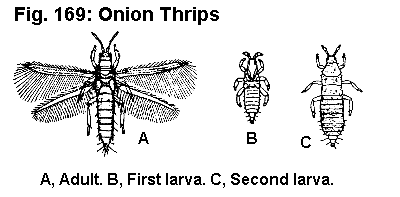 Fig. 169: Onion Thrips, Thrips
tabaci Lindeman, Thripidae, THYSANOPTERA
Fig. 169: Onion Thrips, Thrips
tabaci Lindeman, Thripidae, THYSANOPTERA A, Adult. B, First larvae. C, Second larva.
Return to: MREC Home Page Return to: Index
DESCRIPTION
Adult- Adult females of onion thrips are about 1.1 to 1.2 mm long, yellow, with brownish blotches on the thorax and the median portion of abdomen. Antennae are gray with the first segment lighter than other segments. Males are rare.
Egg- The eggs are very small, about 0.2 mm long, kidney shaped, and white. They are deposited within plant tissues.
Larva- The first instar larva is white, about 0.35 to 0.38 mm long. The second instar larva is yellowish, about 0.7 to 0.9 mm long.
Pupa and Prepupa- The pupa and prepupa are similar to the second instar larvae in color and shape, except for having small wing pads.
 Fig. 169: Onion Thrips, Thrips
tabaci Lindeman, Thripidae, THYSANOPTERA
Fig. 169: Onion Thrips, Thrips
tabaci Lindeman, Thripidae, THYSANOPTERA
A, Adult. B, First larvae. C, Second larva.
BIOLOGY
Distribution- Onion thrips have been found in most countries throughout the world.
Host Plants- Onion thrips are extremely polyphagous. They inhabit leaves, shoots, and flowers of many plants. It prefers to feed on onions, but feeds on many field crops, vegetables, various flowers, and bedding plants. It may cause heavy damage to chrysanthemums and carnations.
Damage- Generally feeding of onion thrips cause yellowing or dropping of leaves, buds, or flowers. High infestation results in stunted growth, brown blisters, white blotches, silvery whitish areas or feeding scars. Young terminal leaves frequently show malformation when heavily attacked, with crinkly surfaces, sunken and raised thin areas, marginal erosion, margin curling inwardly, and a chlorotic yellowish appearance with grayish color along all large veins. Young buds may be killed as soon as they come out. In addition, they freely feed within flowers, attacking the tender portions.
Life History- Onion thrips have six to ten generations depending on temperature. Adults and larvae overwinter in the soil or plant litter on the ground. Pupae and prepupae overwinter in the soil. The average length of development is: 6 to 8 days for eggs, 10 to 14 days for larvae, 5 to 9 days for prepupae and pupae, and about 20 days for a generation. It may take as long as 35 days for a generation if temperature is at 15° C. The lower developmental threshold is about 11.5° C and using this threshold as a base, development required 191 degree days. Adults reproduce parthenogenetically throughout the season, rarely reproduce sexually, and resulting that most adults in the field are female. The average adult life is around 32 days, and pre-oviposition, oviposition and post-oviposition periods are 6.1, 22.5, and 3.9 days, respectively. The average number of eggs laid by an unmated female is 37.4 (20 to 200).
CONTROL
The application of chemical insecticides is the common control measure. The onion thrips problem in an integrated pest management program can be solved by using selective pesticides or by using selective treatments such as soil drenches. A combination of selective chemical insecticides and a predaceous mite in the genus Amblyseius (Acarina: Phytoseiidae) have been successfully used to control this thrips. For specific insecticides and rates, consult current Cooperative Extension Service publications on ornamental plant pests.
University of Florida/IFAS Reference to Pest Control Guides